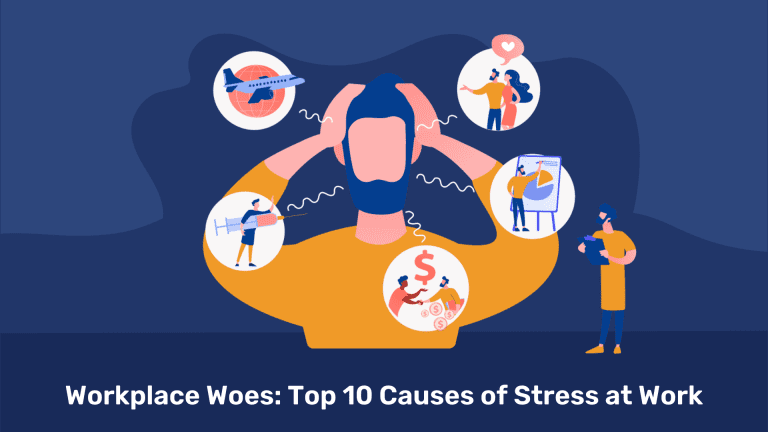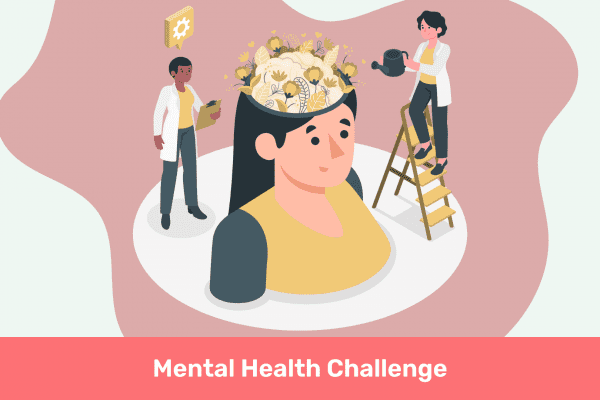Introduction
Are you familiar with that feeling of sinking dread on Sunday evenings when the realization hits that Monday is just around the corner? Or perhaps you’ve experienced those heart-pounding moments when deadlines seem to be closing in faster than you can catch your breath. Well, you’re not alone. Stress at work is an all-too-common experience that affects millions of individuals worldwide and in this article we will be going through top 10 causes of stress at work.
Now, let me ask you: Have you ever wondered about the top causes of workplace stress and how they might be impacting your life? What if I told you that there’s research to back up those feelings of overwhelm and anxiety? Yes, that’s right. Let’s delve into some eye-opening statistics that shed light on the reasons behind our workplace stress and explore how we can better navigate this turbulent terrain.
Put yourself in the shoes of the 61% of workers who, as per the American Institute of Stress, admit to feeling work-related stress. That’s over half the workforce battling the burden of stress on a daily basis. Studies by the World Health Organization reveal that stress-related illnesses cost businesses up to $300 billion annually! It’s time to uncover the culprits behind this alarming trend and arm ourselves with the knowledge to combat workplace stress head-on.
In this article, we’ll embark on a journey to discover the top 10 causes of stress at work, backed by research and real-life experiences. From the relentless burden of heavy workloads to the ever-elusive work-life balance, we’ll explore each stressor in detail, shining a light on the challenges we face daily.
Are you ready to take charge of your well-being and tame the stress monster lurking at your workplace? Let’s dive in and find out!
Top 10 Causes of Stress at Work
Employees struggle with stress at work for a variety of reasons, and understanding their pain points is essential for creating a more supportive and productive work environment. Let’s explore top 10 causes of stress at work:
1. Heavy Workload and Tight Deadlines:
One of the most significant stressors for employees is dealing with an overwhelming workload and tight deadlines. Feeling constantly pressured to complete tasks on time can lead to heightened anxiety and a sense of being unable to cope with the demands of the job.
2. Lack of Work-Life Balance:
The struggle to maintain a healthy work-life balance is a common source of stress for employees. Juggling personal responsibilities with demanding work schedules can leave little time for rest, relaxation, and meaningful personal connections, leading to burnout and reduced overall well-being.
Also Read: Mastering the Art of Improving Work-Life Balance
3. Job Insecurity:
Employees often experience stress when they fear losing their jobs or have concerns about the stability of their positions. Uncertainty about the future can impact an individual’s mental health, leading to decreased job satisfaction and productivity.
4. Lack of Control:
Feeling powerless and having limited control over their work can be deeply frustrating for employees. When they are unable to make decisions or have a say in how they perform their tasks, it can lead to a sense of disempowerment and heightened stress levels.
5. Insufficient Recognition and Support:
Employees who feel undervalued or unsupported by their superiors and colleagues are more likely to experience stress at work. A lack of recognition for their efforts and a dearth of emotional support can negatively impact their motivation and job satisfaction.
6. Organizational Change and Restructuring:
Changes within the organization, such as mergers, restructuring, or leadership transitions, can create uncertainty and stress among employees. Fear of potential job losses and the upheaval of established routines can contribute to heightened anxiety and decreased morale.
7. Poor Communication:
Ineffective communication within the workplace can lead to misunderstandings, conflicts, and a breakdown in teamwork. Employees may feel disconnected and uninformed, resulting in a stressful work environment.
8. High Expectations and Perfectionism:
Employees who place unrealistic expectations on themselves or feel pressured to achieve perfection may experience chronic stress. Striving for unattainable standards can lead to feelings of inadequacy and constant anxiety.
9. Limited Growth and Development Opportunities:
A lack of opportunities for professional growth and development can leave employees feeling stagnant and unfulfilled in their roles. The absence of career advancement prospects may lead to disengagement and stress.
10. Work-related Conflicts:
Interpersonal conflicts with colleagues or supervisors can create a tense and uncomfortable work atmosphere. Dealing with conflicts without proper support or resolution strategies can contribute to prolonged stress.
Understanding these pain points can empower employers to take proactive steps in alleviating workplace stress. By acknowledging and addressing these stressors, employers can help employees thrive and improve overall organizational productivity and well-being.
Why Employees Should Care About Stress at Work?
In today’s fast-paced and competitive work environment, stress has become an alarming epidemic that affects both employees and employers alike. As we’ve explored earlier, employees face a myriad of challenges that contribute to workplace stress. But why should we care about this issue, and how does it impact individuals and organizations? Let’s delve into the statistics and shed light on the significance of addressing stress at work:
The Cost of Stress:
Stress-related illnesses and absenteeism take a toll on businesses’ financial health. In the United States alone, work-related stress costs companies a staggering $300 billion annually, as reported by the World Health Organization. This figure reflects the significant impact stress has on productivity, medical costs, and employee turnover.
Declining Job Satisfaction:
Employees experiencing chronic stress are likely to report lower job satisfaction levels. According to a survey by the American Psychological Association, stressed workers are twice as likely to say they don’t feel valued at work. This lack of satisfaction can lead to decreased motivation and reduced loyalty to the organization.
Productivity Plunge:
Stress can severely impair an employee’s ability to concentrate and focus on tasks. The American Institute of Stress estimates that stress is responsible for a 40% turnover rate among employees and can lead to a 25% decrease in work performance. This productivity plunge directly impacts the bottom line of businesses.
Burnout Blues:
The demanding work culture and constant pressure can drive employees to experience burnout. Research by Gallup indicates that 23% of employees reported feeling burnt out at work very often or always. Burnout not only harms employees’ mental and physical well-being but also leads to increased absenteeism and reduced engagement.
Employee Retention Challenges:
Employees who face excessive stress at work are more likely to seek opportunities elsewhere. A study by Kronos Incorporated revealed that 46% of HR leaders believe that employee burnout is the primary driver of workforce turnover. High employee turnover can result in increased recruitment and training costs for the organization.
Health Hazards:
Stress at work can have severe health consequences. According to the American Institute of Stress, work-related stress is the leading cause of workplace accidents, accounting for up to 40% of reported incidents. Stress can also contribute to various health issues, including cardiovascular problems, anxiety disorders, and depression.
Impact on Mental Health:
Stress can take a significant toll on employees’ mental health. The Anxiety and Depression Association of America highlights that 72% of people who have daily stress and anxiety say it interferes with their lives at least moderately. Prioritizing mental health support in the workplace can lead to a more resilient and productive workforce.
Practical Tips to Reduce Stress at Work
Navigating the bustling world of work can often feel like a juggling act, with deadlines, expectations, and responsibilities vying for your attention. But fear not – there are practical and effective strategies you can implement to dial down the stress levels and restore a sense of balance and calm to your workday. Here are some detailed practical tips to help you reduce stress at work:
Time Management and Prioritization:
Organize your tasks using time management techniques such as the Pomodoro technique or creating a to-do list. Prioritize your responsibilities based on deadlines and importance, allowing you to tackle one task at a time and reduce feelings of overwhelm.
Set Boundaries and Take Breaks:
Establish clear boundaries between work and personal life. Take regular breaks during the workday to relax and recharge, even if it’s just for a few minutes. Stepping away from your desk can help improve focus and reduce stress levels.
Practice Mindfulness and Deep Breathing:
Incorporate mindfulness practices and deep breathing exercises into your daily routine. Simple techniques like deep belly breathing or mindfulness meditation can help calm your mind and reduce stress in high-pressure situations.
Seek Support and Communicate:
Talk to your colleagues or supervisor if you feel overwhelmed. Effective communication can lead to support, collaboration, and potential adjustments in workload or responsibilities to manage stress better.
Exercise and Physical Activity:
Engage in regular physical activity, even if it’s just a short walk during breaks. Exercise releases endorphins, which are natural stress relievers, and can significantly improve mood and overall well-being.
Organize Your Workspace:
A cluttered and disorganized workspace can contribute to stress. Keep your desk tidy and well-organized to create a more calming and focused environment.
Develop Healthy Coping Strategies:
Identify healthy ways to cope with stress, such as journaling, practicing a hobby, or talking to friends and family. Avoid unhealthy coping mechanisms like excessive alcohol consumption or overeating.
Set Realistic Goals:
Be kind to yourself and set realistic, achievable goals. Avoid perfectionism and focus on progress rather than trying to do everything perfectly.
Disconnect from Technology:
Limit the time spent on electronic devices, especially outside of work hours. Create technology-free zones to give your mind a break and prevent constant accessibility to work-related stressors.
Seek Professional Help if Needed:
If work-related stress is severely impacting your well-being, consider seeking support from a mental health professional or counselor. Don’t hesitate to ask for help when needed.
Execution
To implement these tips effectively, start by choosing a few that resonate with you the most. Begin incorporating them into your daily routine gradually. You may find it helpful to create reminders on your calendar or set alarms for breaks to ensure you follow through. Share your stress-reduction goals with supportive colleagues, and encourage each other to practice these strategies together.
Remember that reducing stress is an ongoing process, and it’s okay to experience setbacks. Be patient with yourself, and celebrate even small successes along the way. By making these practical tips a consistent part of your routine, you’ll experience real benefits in your ability to manage stress, improve overall well-being, and thrive in your work environment.
Conclusion
In conclusion, the journey through the causes and effects of stress at work has revealed a sobering reality. Employees around the world grapple with the weight of heavy workloads, the struggle to maintain work-life balance, and the lingering fear of job insecurity. We’ve explored how stress impacts not only their mental and physical well-being but also their job satisfaction and overall productivity. The statistics highlighted the alarming prevalence of workplace stress, signifying that it is a pressing issue that cannot be ignored.
However, amidst the disheartening numbers, there is hope. Practical tips and strategies exist to empower employees to take charge of their well-being and navigate the challenges of workplace stress effectively. Remember, the battle against workplace stress is not just about individual well-being; it is about cultivating a culture that thrives on support, empathy, and resilience.
How Woliba can help?
Woliba is a comprehensive platform that can significantly aid in stress reduction through its diverse range of features including gamified challenges, exercise videos educational, and nutrition instructions, which play a crucial role in managing stress.
With Woliba, employees can foster a healthier lifestyle and a more positive work environment. Experience the transformative benefits of Woliba for yourself and bring the power of well-being to your workplace.
Contact us today to learn more about how we can support your employees’ mental and physical well-being.





